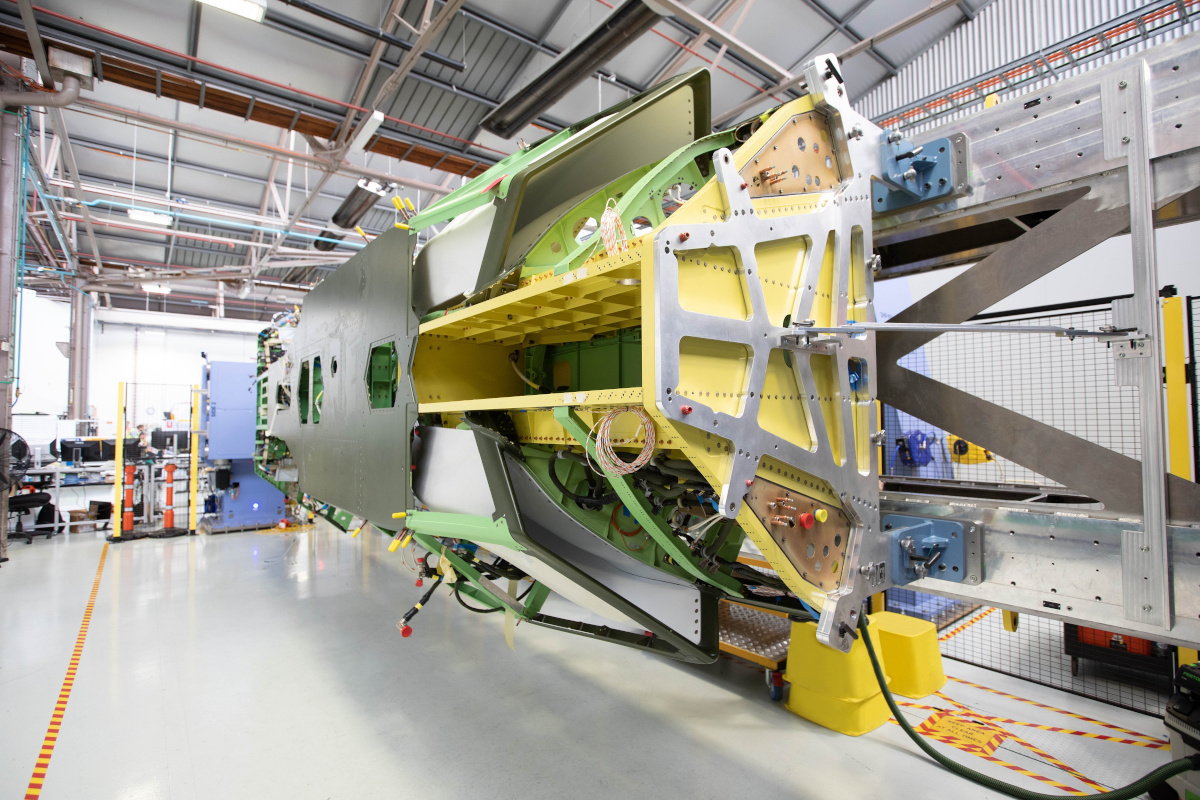Boeing has revealed it has made new progress with the first prototype of its new loyal wingman drone for the Royal Australian Air Force. Recently, for the first time, the unmanned aircraft, which is still in an incomplete state, sat unsupported on its own landing gear and had its main electrical power system turned on.
The Chicago-headquartered planemaker announced the new milestone on Apr. 8, 2020. The company had only revealed that it had completed the bulk of the work on the drone’s fuselage on Feb. 10, 2020. Boeing’s Australia division, based in Brisbane, is leading the project, also known as the Airpower Teaming System (ATS), which it first unveiled publicly in February 2019. You can read more about the program and its implications in this past War Zone piece.
“We’re continuing at pace toward our goal of flying later this year, so that we can show our customer and the world what unmanned capability like this can do,” Dr. Shane Arnott, Boeing’s Airpower Teaming System program director, said in a statement. “The strong contributions from our industry team are powering our progress.”
Boeing’s industry team consists of 16 different firms, including BAE Systems Australia, RUAG Australia, Ferra Engineering, and AME Systems. Those four companies have supplied flight control systems and navigation equipment, the landing gear system, precision machined components and sub-assemblies, and wiring looms, respectively, according to Boeing.

Boeing says it has been integrating and testing various systems on the drone as construction proceeded to help speed up development. The company’s Australian division also conducted at least one flight test of certain systems using surrogate subscale, jet-powered, unmanned test aircraft in November 2019.
The full-size loyal wingman drones will be approximately 38 feet long, will be powered by a bizjet-class jet engine, and have a range of around 2,000 nautical miles. The Royal Australian Air Force plans to network them together with various manned platforms, including its F-35A Joint Strike Fighters and F/A-18E/F Super Hornets, as well as its EA-18G Growler electronic warfare aircraft, E-7A Wedgetail airborne early warning and control platforms, and P-8A Poseidon maritime patrol planes. It’s worth pointing out that all of these aircraft except the F-35As are also Boeing products.
The Airpower Teaming System could offer a game-changing boost in capability for the Royal Australian Air Force at a relatively low cost. The War Zone has highlighted the potential capabilities these drones might provide in the past, writing:
“For Australia, this could offer a major boost in capability at a relatively low cost and without the time and expense required to train traditional pilots. Tethered to manned aircraft via datalink, the ATS drones could provide the attritable pilots of manned aircraft with a more comprehensive picture of the battlespace around them and help them detect threats faster in order to avoid or neutralize them. Combined with the drone’s stealthy design, this could be particularly valuable for helping to further reduce the risks to higher cost assets, such as the F-35, when penetrating deep into heavily defended areas.”
“The modular nature of the design also supports the goal of the rapid integration of new capabilities and payloads with minimal cost and effort. As time goes on, armed versions of the ATS unmanned aircraft could help increase the magazine capacity, sensor diversity, and more of a mixed manned-unmanned force, or even just operate as autonomous swarms.”
“Really, this is a low-risk way for the RAAF to explore semi-autonomous concept of operations, in general. ATS may turn out to have limited potential, but it is extremely cost-effective and could serve as a valuable stepping stone to future unmanned developments.”
Other countries around the world, including the United States and the United Kingdom, are also looking at loyal wingmen type drones.
The U.S. Air Force is already in the process of experimenting with these concepts of operation using Kratos’ XQ-58A Valkyrie and has initiated a separate program called Skyborg to develop an artificial intelligence-driven “computer brain” that could autonomously operate such a drone. In March, the service said it could begin buying larger numbers of “attritable” drones soon to support the Skyborg project.

On Apr. 1, the U.K. Royal Air Force also reactivated No. 216 Squadron as part of its own swarming drone effort. Unfortunately, given the COVID-19 pandemic, this unit will have minimal personnel and only conduct limited activities in the immediate future, according to Jane’s 360.
When it comes to Boeing’s Airpower Teaming System effort in Australia, the company seems well on its way to conducting the first flight of its exciting new loyal wingman drone, which is scheduled to occur later this year.
Contact the author: joe@thedrive.com
